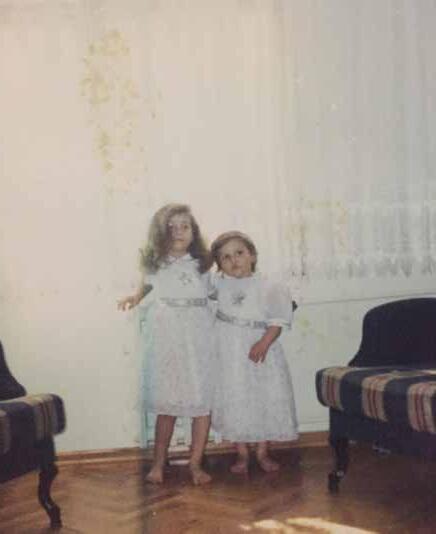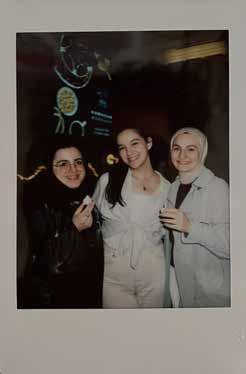
2 minute read
THE JOY OF JUMMAH
from Fig&Olive RA23 Issue
by Fig & Olive
Nilufer Haciosmanoglu thrives in an unorthodox Ramadan in New York City, confronting discrimination and embracing unity. Her journey showcases resilience, diverse experiences and a nostalgic outlook.
During my conversation with Nilufer, we delved into the inevitable absence of campus life and Ramadan spirit at Pratt. As a minority Muslim campus, the atmosphere during this month lacked the usual vibrancy, gatherings, and joy that Nilufer was accustomed to. Strangely, Nilufer described it as feeling like a birthday, “It’s like it’s your birthday and you’re the only one that feels it, everyone around you is acting like it’s just another day…”
Advertisement
What happens when you bring a Turk to the bustling streets of New York City and challenge her to embrace an unorthodox Ramadan? She not only rises to the occasion but thrives in it.

Nilufer Haciosmanoglu, a student enrolled in the Pratt Architecture & Urban Design Graduate program, spoke with me about her experience. Throughout her year-long stay here, Nilufer has demonstrated an unwavering determination to fully immerse herself in the American Ramadan experience, leaving no stranger unfriended and no stone unturned in her journey to make the most of this unique situation.
The lacked sense of community is what really started to sink Nilufer. She explains, in Turkiye, just because the entire country isn’t decorated for Ramadan, the feeling of all being in it together was palpable. She recalled about the joy of jummah (gathering) and seeing people she typically didn’t see throughout the year. For Nilufer, the essence of Islam was discovered through unity and collectivity, where the act of being together amplified the joy of the faith.
Nilufur says “In every action that we do, it’s best to do it with other people.”
Nilufur shares a heartwarming memory that captures the essence of Ramadan nostalgia—a tradition of showing off her special outfit for Eid. With a gleam in her eyes and a smile on her face, she recalls the excitement of accompanying her mother to the mall a day or two before Eid to find the perfect attire. For three consecutive days, Nilufur and her sisters would proudly wear the same outfit, creating a cherished symbol of the festive season.
The significance of these Eid outfits went far beyond their materialistic value; they became a visual representation of the joy and anticipation that permeated the air during Ramadan. As Nilufur fondly remembers, the outfits were not mere clothing but tokens of celebration. Returning home from the mall, she and her sisters would wash their new garments and hang them up outside their closets, almost like a tableau of excitement. It was a beautiful sight—a glimpse into what awaited them on the day of Eid.
The picture below captures a young Nilufur wearing one of her cherished Eid dresses alongside her sister, showcasing their excitement for the special holiday.
Interview With Nilufur
I sat down with Nilufur, to ask her a few questions about this past Ramadan. “IF YOU COULD DESCRIBE WHAT THE CAMPUS CULTURE WAS LIKE DURING RAMADAN 2023, IN THREE WORDS WHAT WOULD THEY BE?”
SADDQA BAHIDRAH:
NILUFUR HOS:
“I CAN GIVE YOU LIKE 10 SENTENCES, BUT 3 WORDS I CAN’T. THE CAMPUS SPECIFICALLY IS REALLY HARD TO DESCRIBE. BECAUSE MOSTLY I FELT LIKE IT DIDN’T FEEL LIKE RAMADAN.
SPECIFICALLY TO THE MSA I FELT JOYFUL , THAT’S ONE WORD I WOULD USE. IT FELT GOOD TO BE AROUND OTHER MUSLIMS, IT FELT LIKE A CELEBRATION. VERY ORDINARY , BECAUSE IT FELT LIKE THERE WERE OTHER REGULAR THINGS. AND QUIET .”
SADDQA BAHIDRAH:
“WHAT FELT ORDINARY TO YOU?”
NILUFUR HOS:
“I WAS THINKING ABOUT THE CAMPUS BEING ORDINARY, NOT RAMADAN. IN THAT SENSE RAMADAN WAS VERY DIFFERENT BECAUSE IT’S NOT WHAT I’M USED TO. THE STUDENTS WALKING ACROSS THE CAMPUS. NOTHING SPECIAL TO THEM IS HAPPENING, BUT SOMETHING VERY SPECIAL TO ME IS HAPPENING.”




